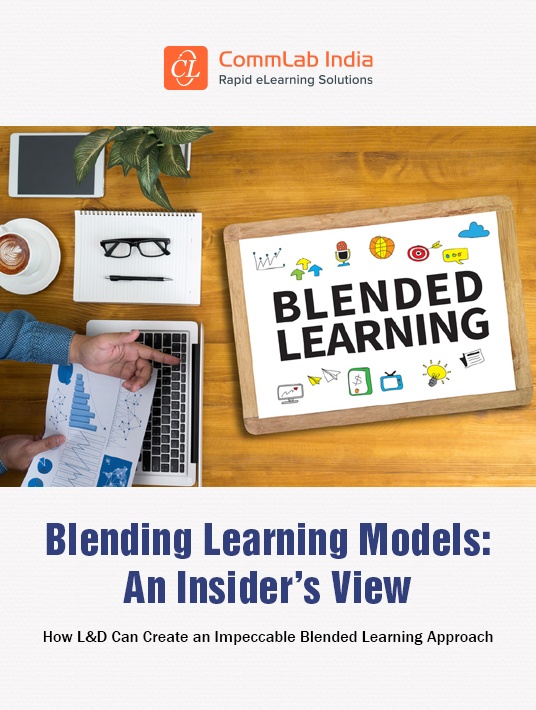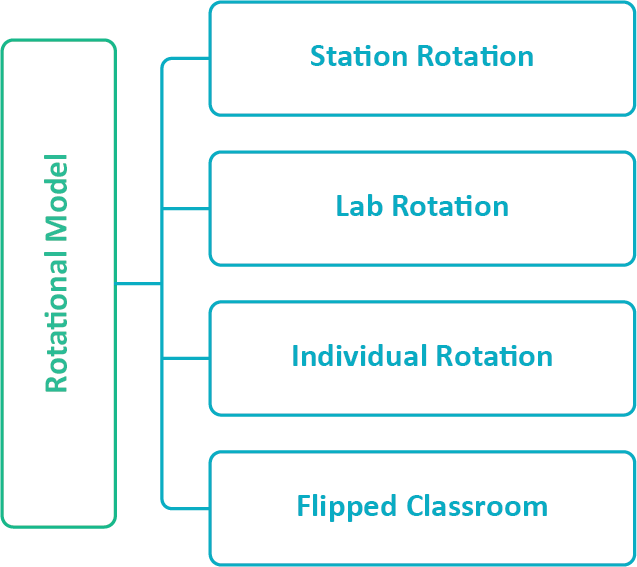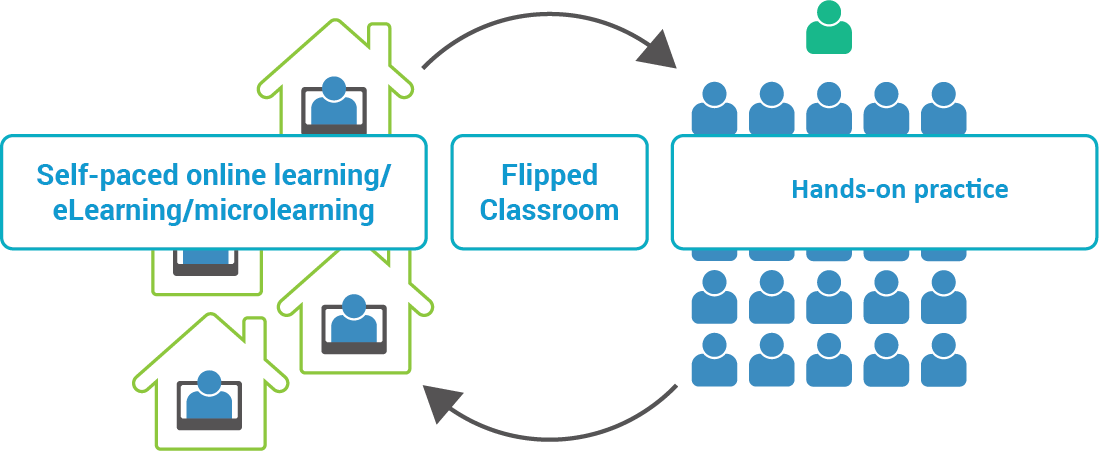Discussing The Most Essential Blended Learning Models
Have you witnessed any conversations around the core blended learning models lately? We all know that blended learning is a combination of classroom and online training. But there are a few misconceptions about how to use the blended format. One of those is that blended learning needs to begin with classroom training followed by online training or with online training followed by classroom. That is so not true!

The truth? There are many more blended learning models out there that can be leveraged for effective training.
4 Core Blended Learning Models
According to the Clayton Christensen Institute [1], there are 4 core models of blended learning: Rotation, Flex, Enriched Virtual, and À La Carte. Although there are many more blended learning models, most of them are based on these 4 core models.

So, let’s go deeper into these core blended learning models and see what they offer L&D managers.
1. Rotation Model
In the Rotation blended learning model, the training program uses different learning modalities, one of which is online learning [2]. Learners are required to follow a fixed schedule that alternates between different training methods such as classroom training, eLearning, and even collaborative group activities and discussions.
There are 4 sub-models under the rotation model:

Of these, the first 3 are primarily used in K-12 learning, while the last one is also used in corporate training. Organizations that follow traditional classroom training as their only training method can benefit from introducing the flipped classroom [3].
What is a flipped classroom?

The Flipped Classroom as the name suggests is a reverse (flip) of traditional classroom training where learners go through online training before they come to the classroom. This equips learners with the prerequisites for classroom training and familiarizes them with the needed concepts. The classroom is then used to deliver in-depth learning or facilitate learners to apply their knowledge.
What the Rotation blended learning model offers L&D managers:
- Greater flexibility (can be used for a variety of learning content and learning styles).
- A fixed schedule (so L&D managers will know exactly which training format their learners are going to be participating in during a specific time period).
- Multiple options for collaborative learning through instructors and peers.
- Opportunities for learners to practice what they learned, thereby filling skills gaps.
- The Rotation model can be a great fit for organizations just getting started with online learning, as online training plays a smaller role in this model compared to other blended learning models [4].
2. Flex Model
Unlike the Rotation model, online training is the main component in the Flex blended learning model. It also includes a certain amount of group instruction in the form of group activities, group projects, or individual tutoring by an instructor. The Flex model offers a customized training schedule, unlike the Rotation model which follows a fixed schedule.

What the Flex blended learning model offers L&D managers:
- Personalized blended learning with the learning modality adjusted to the learners’ needs
- A flexible training plan for learners depending on their need and skill level
- Greater control for learners over their learning experience
- One-on-one support for learners
- Role of instructor adapted to facilitate learning rather than direct delivery
Blended learning: example 1
The requirement from a global healthcare giant was to create training for a group of employees on a document management system, with flexible learning plans. Our solution was a blended learning model based on the Flex and Flipped Classroom model.
The training program began with an eLearning course to bring learners up to speed on concepts. This was followed by an option to continue the training either through classroom training or eLearning [5], depending on the learners’ convenience.
The training program was received with great warmth because of the flexibility offered, and our client achieved 100% completion—a nearly impossible feat for many training programs.
3. Enriched Virtual Model
In this blended learning model, learners primarily learn online with a mandatory face-to-face component included. This could happen in a brick and mortar classroom or through Virtual Instructor-Led Training (VILT) [6].

What the enriched virtual model offers L&D managers:
- A strong training framework for a remote workforce
- Continued learning even during emergency situations (like the present pandemic)
- Training in direct or virtual classrooms
- Online support of instructors through chats or discussion forums
- Opportunities for informal learning
4. À La Carte Model
In the À La Carte blended learning model, learners complete part of the training through traditional classroom training which is then supplemented by online training.
Though both the Enriched Virtual and À La Carte models include classroom training, the former is primarily completed online with only intermittent face-to-face interactions, while in the À La Carte Model, a major part of the training is completed through Instructor-Led Training (ILT), supplemented by online resources.

What the À La Carte blended learning model offers L&D managers:
- Instructor-Led Training as an important ingredient
- Supplemental online training (microlearning formats such as videos, infographics, interactive eBooks, and so on)
- Online training for pre- and post-training
- Reinforcement of learning through online formats [7]
- Online resources for additional information to learners
Blended learning: example 2
In a training program designed for a global pharmaceutical company, we were able to cut down Instructor-Led Training from 5 days to 3 days.
The primary audience consisted of sales professionals who needed to be trained in pharmaceutical products. Learners who did not have a background in life sciences were required to complete a pre-training program before the classroom training. eLearning modules and pre-assessments were used as part of pre-training.
After completing the classroom training, learners were provided access to microlearning modules on product information. This served to reinforce the learning and provide Just-In-Time training for sales professionals to be accessed just before meeting the doctor.
It’s A Wrap
Irrespective of the blended learning model used, there is no denying that this training methodology can enhance the learning experience in corporate training. You also can choose a mix of different blended learning models to get the most out of them, the choice is yours!
If you’re still confused about these different blended learning models and need guidance to make the right choice, download the eBook An Insider's View On Blending Learning Models: How L&D Can Create An Impeccable Blended Learning Approach, for more information. Also, join the webinar on blended learning to discover new solutions to old problems.
References:
[1] Blended Learning Definitions
[2] Fill your Training Plate from the Online Training Buffet
[3] The Flipped Classroom: How does it Benefit Corporate Training?
[4] Busting 6 Big Myths about Blended Learning
[5] 6 Classroom Training Challenges Solved by Online Training
[6] Solutions to Top 3 Challenges When Implementing Virtual Training
[7] One Strategy, Two Goals: E-Learning for Learning and Reinforcement










